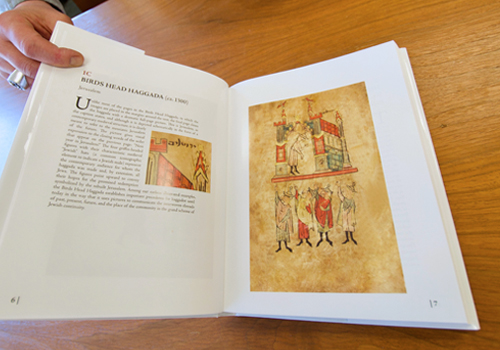It may be the most illustrated book in Jewish history, but the Passover haggada has never been explored quite like this.
“As an art historian and someone familiar with the haggada, the seder and Passover I thought I had the opportunity to fill a gap,” said Adam Cohen, an associate professor in the Department of the History of Art. “No one has written this book before.”
The book in question? Signs and Wonders: 100 Haggada Masterpieces, Cohen’s exploration of more than 700 years’ worth of illustrated Passover haggadot — the written guide to the Jewish Passover seder.
The illustrated haggada has been the centerpiece of the Passover seder since the Middle Ages. Commemorating the Exodus from Egypt, the haggada guides the seder through prayers, blessings, rituals and more, alongside illustrations that can range from beautiful and complex to spiritual, political and even playful.
Signs and Wonders is the first art historical overview of the entire history of the illustrated haggada. With 166 reproductions of full-colour illustrations set alongside insights into the imagery, artists and historical context, Cohen explores the Middle Ages, Renaissance, Modern period and contemporary times.
Cohen set out to write this book seven years ago as a way to explore the panorama of Jewish art and history.
“I hope it serves multiple audiences,” said Cohen. “From scholars who are familiar with some of the material, but not all of it, to people who know about some illustrated haggadot but don’t realize the great diversity of material out there.”
While he won’t say which published illustration he considers to be his favourite, Cohen does admit that many illustrations didn’t make the cut purely due to page count.

With 166 reproductions of full-colour illustrations set alongside insights into the imagery, artists and historical context, Cohen explores the Middle Ages, Renaissance, Modern period and contemporary times. Photo: Diana Tyszko.
“I carefully weighed and considered which illustrations to include,” said Cohen. “For every piece of artwork that I included, there are three to five I had to exclude.”
As part of the research for his book, Cohen scoured through more than 2,000 haggadot at institutions like the University of Pennsylvania, Duke University, and here at the University of Toronto, as well as the National Library of Israel in Jerusalem. He gradually narrowed his list down to an even 100.
Those familiar with the text may recognize interpretations like the Sarajevo Haggada, or more contemporary examples like the Ben Shahn Haggada. But Cohen made sure to include interpretations that might not be so well known.
“Each image in the book was chosen for its own specific reason,” said Cohen. “Interpretations that aren’t so well known showed complexity, depth of thought and interpretive skill or were interesting, innovative and novel.”
For now, Cohen is happy to see where his first departure from academic writing takes him.
“Normally you write something, it goes in the library and that’s it,” said Cohen. “But I want people to learn from the book and use it and enjoy it. That’s the satisfaction you get as a teacher and as a writer — people getting enjoyment in learning from your efforts.”
As for what comes next, now that Cohen has finished his first non-academic book?
He’s going back to the Medieval Period — and footnotes — as he and two U of T colleagues take on a new multi-year project — Art and Architecture of the Middle Ages. They’re aiming to write the book on medieval art and architecture, covering Europe, the Mediterranean, and Central Asia with a focus on Christian art, Islamic art, Jewish art, and more — spanning 1,000 years.
“It’s going to be Medieval Art for the 21st century,” said Cohen.

